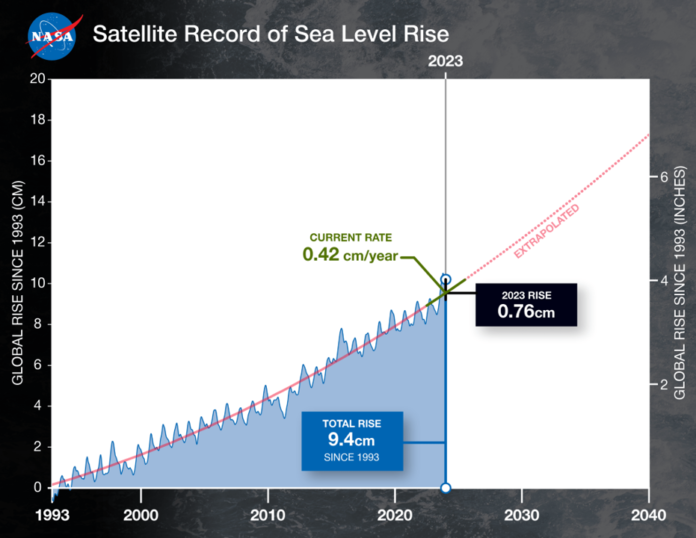Isn’t it bad enough that everything in The Universe appears to be moving away from The Milky Way at accelerating rates, but now we find that ocean levels are equally accelerating? Of course, the latter’s acceleration is not at the same speed. But with the oceans being closer to home the immediate impact is greater. The Universe issue won’t matter much for billions of years. The rising sea levels matter now and in the future.
The latest satellite data based on 25 years of observation shows that sea level rise by 2100 will double the original projections based on climate models. Originally the increase was expected to be a steady rate. But the data says something entirely different.
The cause is accelerated melting in Greenland and Antarctica with current projections indicating mean global sea levels will rise by 65 centimetres (26 inches). The implications for cities lying on coastlines are significant.
Steve Nerem, a professor of Aerospace Engineering Sciences at The University of Colorado – Boulder, who is working with NASA’s Sea Level Change project, believes the projected rise is a conservative estimate based on changes seen in the Arctic and Antarctic.
How is sea level measured? Since 1992, a series of satellites have been remotely monitoring the ocean surface using onboard altimeters. They initially observed an annual rise of 1.8 millimetres (0.07 inches) in 1993. Today the rise is 4.2 millimetres (0.17 inches) per year. The total rise since 1993 is 9.4 centimetres (4 inches).
The satellite data has been supplemented by tide gauge data collected for more than three decades. What is a tide gauge? It is an Earth-bound piece of monitoring equipment with sensors to record surrounding water level heights. Before we started measuring global sea level rise, tide gauges were used to support safe navigation along coastlines.
Gary Mitchum, at the College of Marine Science, University of South Florida, notes that the tide gauge data is “essential for determining the uncertainty in the global mean sea level acceleration estimate.” These Earth-based metrics provide backup to the satellite observations.
In the past, sea levels have dropped after volcanic eruptions and La Niña Southern Ocean oscillations, and have risen from thermal expansion during El Niños like the current strong one which no doubt has raised ocean levels temporarily.
The melting of polar ice from Greenland and Antarctica isn’t just contributing to rising seas. A 2021 Harvard study notes that when the glacial ice from these two areas melts it impacts the land lying beneath. We are still witnessing a phenomenon called isostatic rebound in North America from the last Ice Age which started 2.6 million years ago and ended in geological time very recently a mere 11,000 years ago.
Sophie Coulson is the lead author of the 2021 Harvard study published in Geophysical Research Letters. In an article in The Harvard Gazette, Coulson talked about the various forces imposed on Earth’s crust by tectonic movement. She stated, “We need to be able to separate…motion generated by modern-day ice-mass loss.” In addition, she noted that “Earth is actually still rebounding from that ice melting.”
Coulson is making reference to an observed phenomenon, that parts of North America continue to rise from the disappearance of the ice causing warping of the continental landmass hundreds of kilometres away. A good example is the land around the Chesapeake Bay warping downward as Pennsylvania does the opposite and rises to the northwest.
Another consequence of melting polar ice is changes to the composition of ocean surface water. Freshwater ice melt is diluting the saltwater. Freshwater’s lower specific gravity causes it to overlay heavier saltwater layers.
In addition, the land ice melt contributes to changes in the amount of sea ice exposing more surface water to the atmosphere with its increasing burden of carbon dioxide (CO2) from anthropogenic sources of pollution. The greater exposure means a warmer ocean surface which can then absorb more CO2 which creates carbonic acid which makes the Arctic Ocean more acidic, threatening regional biodiversity.
For humans on land, these dynamic forces represent a variety of challenges. If sea levels are accelerating, coastal communities will be further subjected to flooding. It means coastal freshwater aquifers will experience more saltwater intrusion. And if biodiversity within the ocean is negatively impacted, it means that communities dependent on the largesse of the ocean will face greater food insecurity.
















